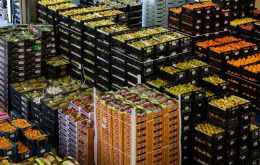MercoPress. South Atlantic News Agency
Tag: Cereal Price Index
-
Monday, July 15th 2024 - 07:56 UTC
FAO June food commodity prices remained unchanged: cereals down, offset by dearer oils, sugar and butter

The benchmark for world food commodity prices was unchanged in June, as increases in international quotations for vegetable oils, sugar and dairy products offset a decrease in those for cereals, FAO reported this last week.
-
Saturday, July 9th 2022 - 09:06 UTC
Food-commodity prices in June remain 23,1% higher than a year ago, FAO report

The barometer for world food commodity prices declined slightly in June for the third consecutive month, the Food and Agriculture Organization of the United Nations (FAO) reported on Friday
-
Sunday, October 10th 2021 - 19:30 UTC
World food prices rose 1,2% in September and 32,8% year to year, FAO

World food commodity prices rose in September, led by tightening supply conditions and robust demand for staples such as wheat and palm oil, the Food and Agriculture Organization of the United Nations (FAO) reported. FAO's Food Price Index averaged 130.0 points in September, up 1.2% from August and 32.8% higher than in September 2020. The index tracks monthly changes in the international prices of commonly traded food commodities.
-
Thursday, October 4th 2012 - 19:52 UTC
FAO Prices Index up 1.4% in September pushed by dairy and meats

Following two months of stability, the FAO Price Index rose slightly in September 2012, up 1.4%, or 3 points, from its level in August. The Index, based on the prices of a basket of internationally traded food commodities, climbed to 216 points in September from 213 points in August.
-
Monday, March 19th 2012 - 15:41 UTC
FAO forecasts second highest on record wheat crop for 2012 with 690 million tons

FAO forecasts that 2012 world wheat production will be the second highest on record at 690 million tonnes. According to FAO quarterly Crop prospects and food situation report forecast a 2012 wheat crop 10 million tons or 1.4% down from the record 2011 harvest but still well above the average of the past five years.
-
Monday, February 13th 2012 - 21:00 UTC
FAO Food Price Index up 2% in January, first increase since July 2011

The FAO Food Price Index rose by nearly two percent or four points from December to January, its first increase since July 2011. According to FAO prices of all the commodity groups in the index registered gains last month with oils increasing the most followed closely by cereals, sugar, dairy products and meat.
-
Friday, November 4th 2011 - 08:20 UTC
FAO food price index drops in October but remains higher than in 2010 and volatile

The FAO Food price index dropped to an 11-month low in October, declining 4%, or nine points, to 216 points from September. Nonetheless prices still remain generally higher than last year and very volatile, FAO said.
